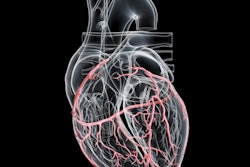
Coronary CT angiography (CCTA) might not be an ideal diagnostic tool for patients presenting to the emergency room with acute chest pain, according to a study published online November 14 in JAMA Internal Medicine. Researchers found that CCTA increases the length of stay without improving clinical outcomes any more than clinical evaluation alone.
In a retrospective analysis of data from the Rule Out Myocardial Ischemia/Infarction Using Computer-Assisted Tomography (ROMICAT) II trial, the researchers assessed the efficiency of combining noninvasive testing, including coronary CTA, with clinical evaluation to rule out acute coronary syndrome (ACS) in patients with acute chest pain.
Their analysis of the data showed that CCTA and other noninvasive cardiac testing led to a longer stay, more radiation exposure, and greater cost without altering the rates of intervention in low- to intermediate-risk patients, according to lead author Dr. Samuel Reinhardt and colleagues from Washington University in St. Louis.
"Neither CCTA nor stress testing can diagnose ACS, which is a clinical diagnosis made by medical history, [electrocardiogram] findings, and biomarkers," they wrote. "Reliance on noninvasive anatomic or functional testing to do so is misguided."
The cost of CCTA
Discerning which patients with acute chest pain have acute coronary syndrome is a diagnostic challenge for physicians involving a variety of invasive and noninvasive techniques. Physicians often elect to use coronary CT angiography for this purpose because of its high negative predictive value in diagnosing coronary artery disease (CAD).
A lack of suspicious findings on a CCTA study effectively rules out coronary artery disease and ACS along with it, the authors wrote. But positively detecting ACS is another matter, since few patients with coronary artery disease also have ACS.
"The presence of CAD on CCTA in a patient with chest pain does not prove a causal relationship between the chest pain and an ACS," the authors wrote.
Rather, the diagnosis of ACS in patients with chest pain depends on patient history, physical examination, electrocardiogram (ECG), and biomarker analysis drawn from clinical evaluation and not necessarily coronary CTA, the authors continued.
To assess this reasoning, the researchers performed a secondary analysis of data from the ROMICAT II trial, which used CCTA to evaluate patients 40 to 74 years old who presented with acute chest pain at nine U.S. hospitals during weekday, daytime hours between April 2010 and January 2012.
Among the 1,000 patients in ROMICAT II, 118 received only clinical evaluation and the other 882 underwent additional noninvasive cardiac testing, which included CCTA (474 patients), a treadmill exercise stress test, stress echocardiography, and/or a myocardial perfusion SPECT study.
Patients who only had a clinical evaluation stayed in the emergency room for a shorter amount of time, incurred a lower cost, and received less radiation exposure and diagnostic examination than patients who had an additional CCTA study (JAMA Intern Med, November 14, 2017).
| Effect of adding CCTA to clinical evaluation for acute chest pain | |||
| Clinical evaluation alone | Clinical evaluation plus CCTA | p-value | |
| Length of stay | 20.3 hours | 27.9 hours | < 0.001 |
| Total cost (median) | $2,261 | $2,584 | 0.009 |
| Radiation exposure | 0 | 9.9 mSv | < 0.001 |
| Diagnostic testing | 2% | 11% | < 0.001 |
Performing CCTA after clinical evaluation did not reduce major adverse cardiac events or detect ACS more effectively than clinical evaluation alone. Moreover, both modes of diagnosis resulted in the same rate of surgical intervention in the 28-day follow-up period.
The CCTA controversy
Major trials such as the Prospective Multicenter Imaging Study for Evaluation of Chest Pain (PROMISE) and the Scottish Computed Tomography of the Heart (SCOT-HEART) trial have shown coronary CTA to be clinically useful in cases of acute chest pain -- reducing adverse event rates and facilitating care management changes.
Subsequent research since these trials has also indicated that CCTA can help reduce the need for invasive coronary angiography as well as the duration of hospital stays. Moreover, studies have shown that CCTA provides clearer results in chest pain, which can help physicians in their decision-making process.
Somewhat defying these conclusions, the current study suggests that coronary CTA is not the best alternative for diagnosing ACS in low- to intermediate-risk patients with acute chest pain.
"The goal of the [emergency department] evaluation is not to make a diagnosis of CAD, but rather to rule out the diagnosis of ACS," the authors wrote. "Our results and those of others suggest that noninvasive testing does not achieve this goal in the [emergency department] setting."
This claim comes with limitations acknowledged by the authors and further reiterated by other physicians -- including a relatively short follow-up period of 28 days and the evaluation of patients only during weekday, daytime hours.
"While the findings are suggestive that [CCTA] testing may safely be omitted in such patients, the results are not definitive," wrote Dr. Gregory Curfman of Harvard Medical School in an accompanying editorial. "The study was not designed or powered to address this question, and patients were not randomized to testing."
Even suggesting that CCTA be omitted seems like a stretch, Dr. Joseph Schoepf from the Medical University of South Carolina (MUSC) told AuntMinnie.com in response to this study.
"Trying to derive sweeping conclusions based on this small sample size falls short in the face of much larger investigations showing substantial improvement in patient management and outcome when CCTA is used over clinical evaluation," Schoepf said. "The advantages of using CCTA for acute chest pain testing would be much more relevant if applied broadly across the field like radiologists do at all times instead of only during bank hours."
The future of CCTA
While CCTA has proved its potential as a diagnostic tool, the findings of this study, at a minimum, ensure that the ongoing debate regarding the most appropriate strategy for diagnosing ACS will continue. What is certain is the need for further clinical research equipped to tackle this issue on a larger scale.
This study should motivate the performance of a randomized clinical trial of noninvasive testing to address this important clinical question, according to Curfman.
"While awaiting a trial, clinicians may wish to consider following patients with low-risk chest pain and reserving noninvasive testing if indicated by subsequent events," he wrote.




















